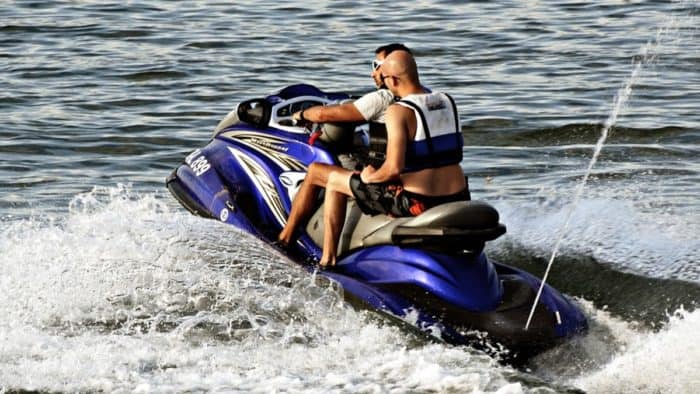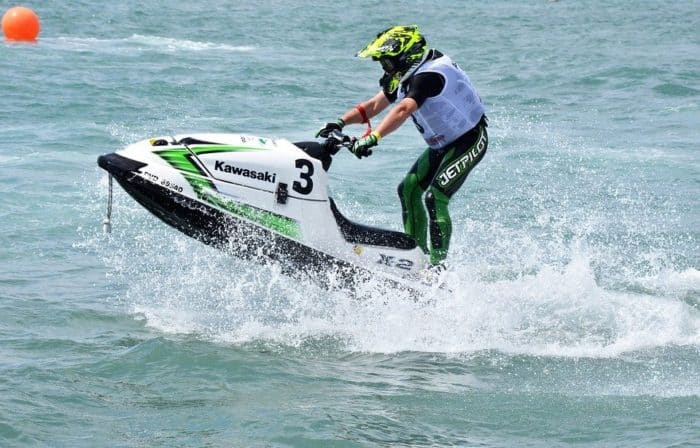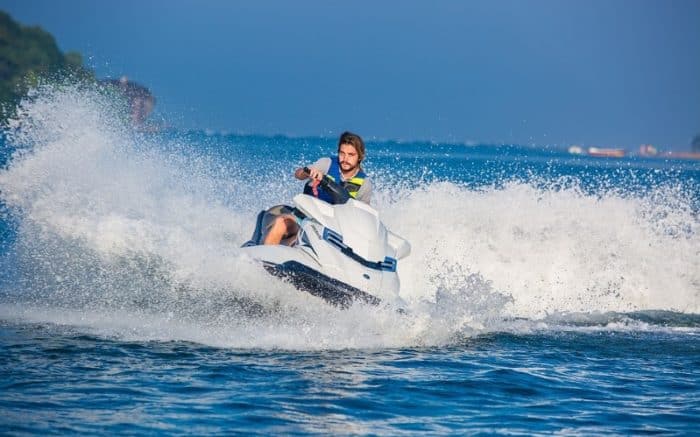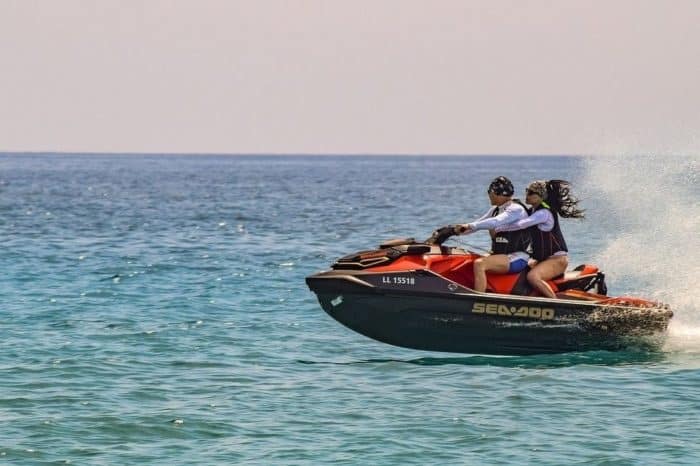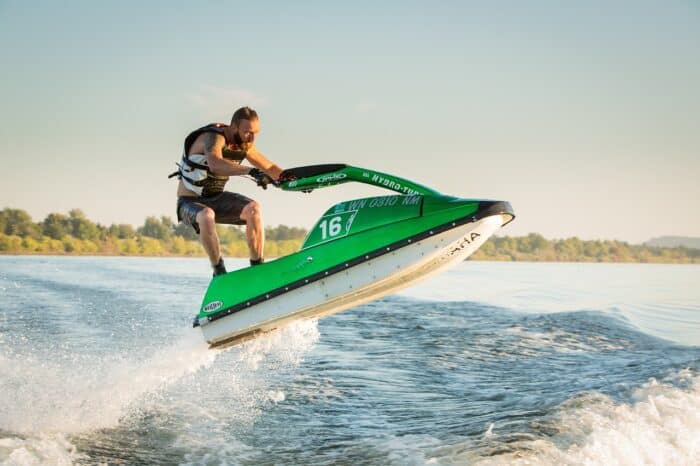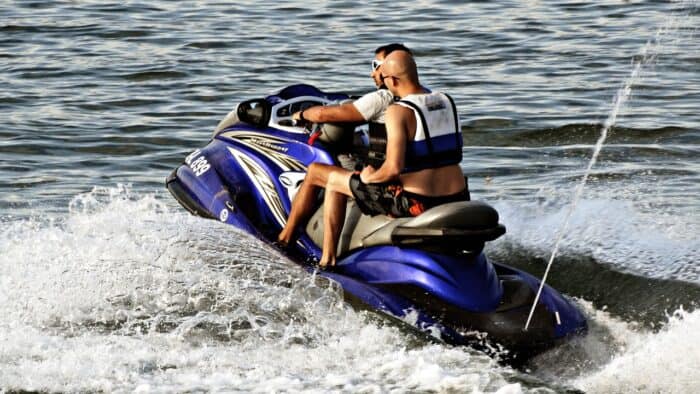What Is A PWC? Understanding Personal Watercraft
PWC stands for personal watercraft. You might better know a PWC by names like Jet Ski and Sea-Doo. PWC is the generic name that applies to any personal watercraft regardless of who made it.
Defining What A PWC Is
A personal watercraft is a small jet-powered watercraft that the operator either sits or stands on to operate. This is different from most boats which you must be inside of it operate. So what else makes something a personal watercraft? There are a few defining characteristics of any personal watercraft that will separate it from a traditional boat or other vessels.
- A PWC uses an inboard jet propulsion drive to move through the water. This is significantly different from a traditional engine with an outboard propeller. In a personal watercraft there is an internal impeller. Water is sucked into the engine through a grate in the bottom of the craft. A pump pulls it in sort of like a vacuum. It hits the impeller, an internal propeller, which then shoots the water out the back. You’ll notice in many PWC when you get going that there’s a blast of water out the back. In some models, this can shoot up quite high. This is the impeller blast. The force of this water being blasted out is what moves the PWC forward.
- The engine is still gasoline powered and ignited by electrical ignition like a traditional outboard, it’s just hidden inside the vehicle.
- The impeller fills the entire tube through which the water jet pump sucks in the water. The engine powers both the pump and the impeller. The impeller forces the water out of a nozzle at the rear of the PWC which is connected to the steering column. As you steer left or right, it moves the nozzle and redirects the blast of water from the impeller.
- Although safety precautions always need to be taken with any vehicle on the water, PWC are often considered safer for people to be near when they’re idling thanks to the fact the impeller is concealed within the hull. There’s no chance of accidentally getting tangled in the blade and getting injured. Likewise, it is rare for the impeller blades to ever get tangled or damaged because of their location.
- A typical PWC is designed for single person use but they are capable of handling a passenger sitting behind the driver, similar to a motorcycle. Some models are larger and may handle up to three or more passengers plus a driver. Sitting standing or kneeling are all possible depending on the model
- According to the US Coast Guard, a PWC qualifies as an inboard boat. That’s because, even if it uses jet propulsion, it still has an inboard motor powering it. This is important for understanding what rules you need to follow when you’re operating a PWC. That said, PWC are almost always subject to more rules than traditional boats that can change by state or body of water. It’s always important to check with local laws before you go boating if you plan to use a PWC.
- Many of these rules govern safety equipment required and also the age of the operator. PWC really appeal to younger boaters so many states have specific rules in place about how old they have to be or who has to be with them when they operate the craft. There may also be laws regarding the time of day you can use a PWC, no-wake zones, environmentally sensitive areas, speed restrictions, PWC emissions, and so on.
PWC Types
There are two main types of PWC that you’ll see on the water.
Runabout
The most popular seems to be the runabout style.
- These are the ones that allow you to sit down giving the overall effect of a motorcycle on the water.
- Typically these have room on the back for at least one more person, but some can seat as many as three.
- They can be powerful enough for water skiing.
Standup
The other style which you may run across is a standup style, although you can also kneel to operate them.
- These are actually the original style of PWC and they date back to 1972.
- They’re a lot more rare these days and tend to be used more often for doing tricks, things like wake jumping.
- Stand up models are less popular because it takes a lot more skill to manage one. They’ll tire you out a lot faster because they’re harder to control and take more effort.
- Only one person at a time can be on a stand up style and then tend to have lower horsepower and less powerful engines because they’re smaller and lighter than the sit down versions.
Do PWC Require Specific Safety Equipment?
A PWC is not a toy. That sounds like a boring warning from your dad, but it really needs to be emphasized because these are really fun vehicles. And the more fun something is, the more likely you are to start thinking of it like a toy. You want to have fun on one, and you should, but you need to be responsible, too. And you need to make sure others are responsible. Kids love jet skis, and as an adult it’s on you to make sure if kids are under your care they’re using it the right way with the required safety equipment.
- Life Vests. In nearly every state it’s mandated that the operator of a PWC has to be wearing a US Coast Guard approved life jacket. This is why it’s important to make sure you know the local laws but I will say that, regardless of whether or not the rules explicitly state you need to wear a life jacket, you really should always wear a life jacket when operating a personal watercraft. According to USCG numbers, personal watercraft account for the second highest number of injuries in boating accidents. In 2017 there were 670 PWC casualties and 46 deaths.
- Fire Extinguisher: This is a legal requirement for operation of a PWC by USCG regulation.
- Deadman Switch. In addition to a PFD, a deadman switch is something that all PWC come with and one that should always be used. You connect yourself to the start/stop with a lanyard so that if you fall off the PWC, it cuts power to the craft. This is beneficial because it ensures the PWC won’t take off unmanned and leave you stranded and it also means it can’t run into you or anyone else.
- Wetsuit. A wetsuit is something some riders, especially those engaging in competitions on PWCs, prefer to wear.
- Eye protection. Though eye protection is a recommended piece of safety gear, more often than not it’s something you’ll only see in competitions.
- Gloves. Like eye protection, competitive riders will wear gloves very often.
Being aware of your surroundings is a major safety concern when operating a PWC. People sometimes use them too close to swimmers which can be a real danger. Even though they handle amazingly well, their speed can put people in the water at risk due to reaction time being pushed to its limits in the face of an incredibly fast rate of speed.4
PWC Rules
As a Class A inboard motor vessel, as defined by the USCG, personal watercraft are subject to the same laws and regulations as those vessels. That means your PWC must;
- Have a working fire extinguisher on board
- Follow load capacity rules as pointed out in your owner’s manual/capacity plate
- Have a working sound signal device such as a horn or whistle
- Be registered in the state in which you live
- Follow all Rules of the Road
The Bottom Line
Personal watercraft are chiefly used by single riders, either standing or sitting. Some styles offer the option of having one or more passengers. The United States Coast Guard says that a PWC is “a craft which is less than 16 feet in length and designed to be operated by a person or persons sitting, standing or kneeling on the craft rather than within the confines of a hull.”
PWC are mostly used for fun on the water and offer a lot less versatility than the average boat as a result. You’re not having a family outing or a fishing trip on a jet ski. You may see Coast Guard or life guards also using them as rescue or patrol vehicles thanks to their speed and maneuverability. But pound for pound, when you want to have fast-paced fun on the water, you won’t find a lot of better options than a good quality PWC. Just make sure you doing it safely!
Categories: Personal Watercraft
